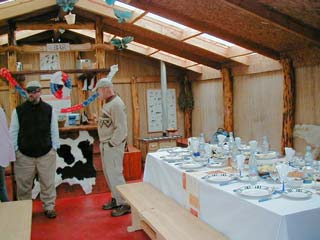
Dennis crossing the creek at Monte Verde.

We’re at breakfast now, again looking at the volcano across the lake. Some low overcast has dimmed the light, compared to the bright sunlight that woke us up.
Turns out that what we thought was Osorno is Osorno’s younger cousin, Calbuco. We went walking down through the town this morning and spotted a larger volcano further down Lake Llanquihue. Its peak was already lost in the clouds that moved in while we were having breakfast.
The walking tour kicked off at 11am this morning. After some brief introductions, we boarded the bus (a new acquisition by EcoTours which was running this event for Country Walkers). The took us to an archeological site, Monte Verde, that predates the Clovis site in New Mexico by at least 1000 years or more. Originally uncovered in the 1970’s (1976?), the carbon dating of this settlement was controversial as it challenged accepted theories on the pre-historic settlement of the Americas. The site itself is so non-descript that you could drive by it and not notice it. The site was discovered when a farmer started to cut through a creek bank to make a crossing for his ox cart and uncovered a mastodon tusk. (Wikipedia link)
Eventually they found the foundations of a number of buildings, and perhaps most amazingly samples of soft tissue (meat) on the mastodon bones! DNA analysis anyone? Other “soft tissue” artifacts included pieces of skin/leather and woven reeds used as rope and string. The soft tissue samples survived because they were buried in peat which results in an anoxic (oxygen-free) environment (I think it was also acidic) that preserved these samples.
Amazing that the place merely looks like a wide spot in the creek
From there we continued on to a farm where Jorge (one of the EcoTour guides) had a meal of lamb and chicken prepared. The meat was cooked over coals. The lamb was OK, but the chicken was fabulous. The farm had llamas, chickens, sheep.
From there we went to a “national monument” preserving some of the temperate rain forest that once covered the entire central valley in the part of Chile.
The rain forest had narrow paths leading through the dense vegetation (remarkably dense). One of the main features was the alerce, a slow growing redwood that was used a primary building material for houses in the area. The tree is now protected by law and only exists in isolated, poorly accessible areas, or in preservations like the one we visited.
From the rainforest reserve, we walked the remainder of the afternoon on a country road through a farm raising cattle. There was one stretch of the road that was literally covered with cow manure – wet and runny. When we got to the destination, where the bus (the new, shiny, 3-week old bus) was waiting, here were twenty folks with their boots covered with manure. There were some mud puddles around that I used to get most of the stuff off, but I think most of our fellow walkers were glad to shed their boots when we returned to the hotel.

We ate lunch at the farm is owned by Jorge (left), who is one of the original 'authors' of this tour.
One thing that strikes me about this region of Chile is the amount of water. The annual rainfall is >2.5 meters (over 100 inches)! Of course to support a rain forest you need that kind of precipitation. There were a lot of drainage ditches on the farms we walked through, usually about two to three feet deep and one foot wide. Apparently the ground is so soggy that farmers use sleds in the fields rather than wheeled carts because the wheeled carts would get mired in the wet soil.
We went to dinner at a local restaurant as a group. Prior to that, Jonathan and I had returned to the bar to write in our journals (i.e. the previous entry) when we were joined by Dennis Chorba (at that point I had stopped writing). Dennis is a retired lawyer of the corporate variety. He still serves on the Board of Directors of his company, but is active in an ecumenical faith-based effort providing business loans to small, sometimes a single individual, businesses in the developing world. Fascinating stuff.
So we shared drinks with Dennis, which he graciously paid for. We adjourned to the restaurant where we were joined by Maria and Elizabeth Brandon. It was a lively and upbeat evening. In appreciation for Dennis’ generosity, we went a bottle of merlot to his table.